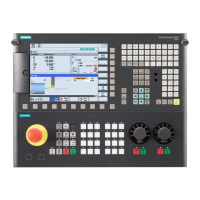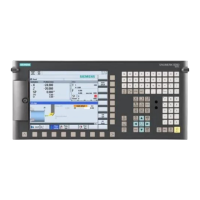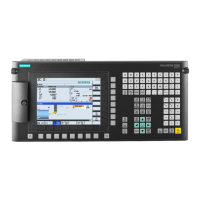Programming
2.7 Functions
Expanding the user interface
Commissioning Manual, 11/2006, 6FC5397-0DP10-0BA0
2-87
2.7.16 Load Mask (LM)
description.
The LM function can be used to load a new dialog.
Master dialog/Sub-dialog
A dialog, which calls another dialog, but is not ended itself, is referred to as a master dialog.
A dialog that is called by a master dialog is referred to as a sub-dialog.
Programming
Syntax: LM
("Identifier"[,"File"] [,MSx [, VARx] ] )
Description: Loads dialog
Parameters: Identifier Name of the dialog to be loaded
File Path name (HMI file system or NC file system) of the
configuration file, default setting: Current configuration
file
MSx Mode of dialog change
0: (Default setting) The current dialog disappears; the new
dialog is loaded and displayed. EXIT will send you back
to the standard application. You can use the MSx
parameter to determine whether or not the current
dialog should be terminated when changing dialogs. If
the current dialog is retained, variables can be
transferred to the new dialog.
The advantage of the MSx parameter is that the dialogs
do not always need to be reinitialized when they are
changed; instead, the data and layout of the current
dialog are retained and data transfer is made easier.
1: The current master dialog is interrupted when the LM
function is initiated; the new sub-dialog is loaded and
displayed. EXIT will end the sub-dialog and return to the
point at which the master dialog was interrupted.
In the master dialog, the UNLOAD block is not
processed during the interruption.
VARx Requirement: MS1
List of variables, which can be transferred from the
master dialog to the sub-dialog. Up to 20 variables, each
separated by a comma, can be transferred.
